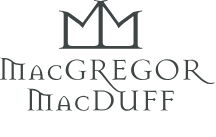Although the two words share many similarities, there are some key differences between the words “plaid” and “ tartan” that should be considered, especially when it comes to the US and UK differentiations.
The word “tartan” refers to cloth with patterns of coloured check boxes and intersecting lines and, importantly, is associated with a clan. It is predominantly made of 100% pure worsted wool and is the cloth used to make kilts, other highlandwear accessories and clothing.
In the UK, the word “plaid” refers to the long, often rectangular shaped, tartan piece that is worn over the shoulder of a kilt outfit, usually worn by Grooms at their weddings. So you would purchase “a” plaid from MacGregor and MacDuff. You would not purchase ‘some’ plaid.

In the US however, you would not go to a store to buy 'a' plaid. This is because in the US, the word 'plaid' describes any checked cloth of two or more colours. You would therefore go to buy ‘some’ plaid, because it is the cloth you are ordering, not a particular product.
To many Americans, plaid and tartan are the same thing
Plaid and tartan both contain horizontal and vertical lines that intersect at 90 degree angles. Plaid is used in the US to describe a multi-coloured, cross-lined pattern.
Americans do use the word tartan, but when they do, it should be to describe the plaid associated with a clan. So to complicate matters, all tartans are plaids, but not all plaids can be tartans.
The repetitive pattern of lines on tartan does not change throughout the whole length of the cloth. This is the ‘sett’ pattern, which is usually 5-6 inches and repeats over and over.
Plaids differ to this in that the sett pattern is not always present and importantly doesn't need to be present. Whereas with tartans, the “sett” pattern is key to differentiating it from other tartans.
So the most important difference for people in the US to note between tartan and plaid is that tartan is plaid associated with a clan. Whereas plaid holds no association with a historic clan.
A good example of plaid is Gingham, which has two intertwining colours, but which is not associated to a historic clan or family.
In addition, all tartans are registered with the Scottish Tartan Authority and can even be designed using our tartan design service. The final piece would be to register the tartan against a clan or family or organisation. You would not do this with a plaid pattern.

What's the difference between tartan and check?
A check is a pattern of stripes consisting of crossed horizontal and vertical lines which form squares. Tartan is slightly different and consists of a pattern of criss-crossed horizontal and vertical bands, which can be in multiple colours.
What does tartan mean?
Tartan was historically woven by intersecting multiple colours using natural dyes. When woven in both directions (the warp and the weft) it produced a check pattern. Many tartans used the local plant-life which created the dyes for the cloth, giving them a unique colour. This, amongst others reasons, helped to tell friends and enemies apart in battle.
Is plaid an American word?
The word plaid originates from the Gaelic word for blanket.
What is considered plaid in the UK?
In the UK, the word is pronounced ‘played’ and was first used in Scots Gaelic around 1510 in reference to the word blanket.
For Scottish folk, the word plaid describes a specific, rectangular piece of tartan worn over the left shoulder, accompanied by a plaid brooch. It acts as an accessory to Highland Dress outfits. The plaid worn over the shoulder is thought to have been incorporated in Highland Dress since the 16th century.
Plaids come in many various styles including the:
- Belted Plaid
- Arisaid Plaid
- Shepherd’s Plaid
- Fly Plaid
- Straight Plaid
- Pipers Plaid
- Drummers Plaid
Although a Fly Plaid is the most popular to wear with traditional Highlandwear.

So for our US customers, when using the word 'plaid’, if it is associated to a clan, then it is actually a 'tartan'. The words are both undeniably versatile in use, but always remember this key defining feature of the association of a clan.

